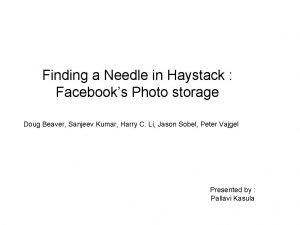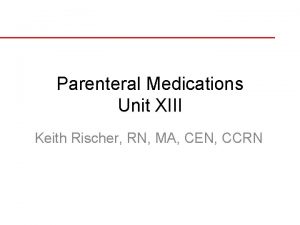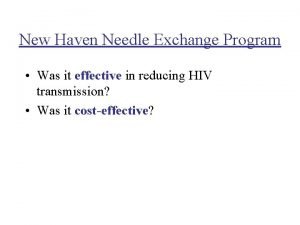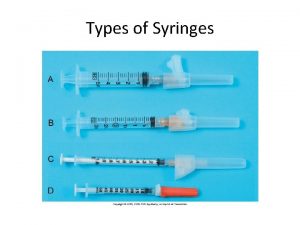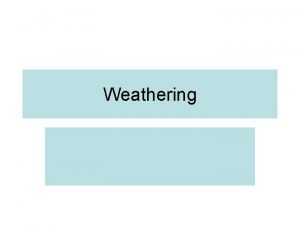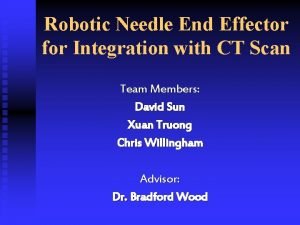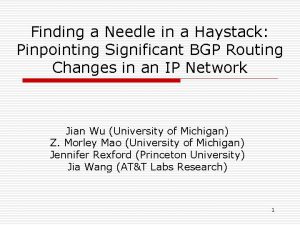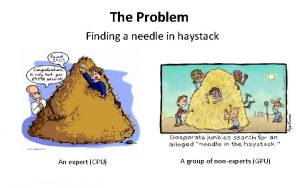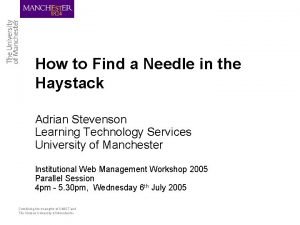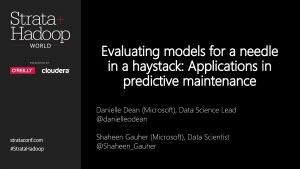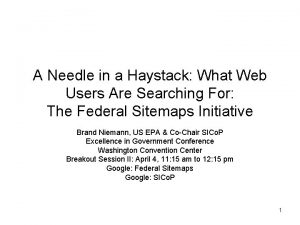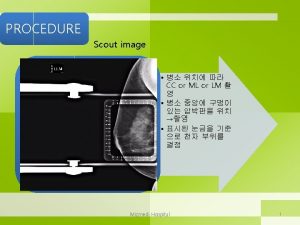Finding a Needle in a Haystack Pinpointing Significant























- Slides: 23

Finding a Needle in a Haystack: Pinpointing Significant BGP Routing Changes in an IP Network Jian Wu (University of Michigan) Z. Morley Mao (University of Michigan) Jennifer Rexford (Princeton University) Jia Wang (AT&T Labs Research) 1

Motivation destination Failure AS 4 Disruption AS 2 AS 3 Congestion BR C A BR C B AS 1 BR C C Mitigation A backbone network is vulnerable to routing BR C D changes that occur in other domains. source 2

Goal o Identify important routing anomalies n n n Lost reachability Persistent flapping Large traffic shifts Contributions: • Build a tool to identify a small number of important routing disruptions from a large volume of raw BGP updates in real time. • Use the tool to characterize routing disruptions in an operational network 3

Interdomain Routing: Border Gateway Protocol “I can reach 12. 34. 158. 0/24” AS 1 BR BR C 12. 34. 158. 0/24 e. BGP data traffic BR BR C AS 2 i. BGP “I can reach 12. 34. 158. 0/24 via AS 1” BR BR C e. BGP data traffic BR BR C AS 3 12. 34. 158. 5 o o Prefix-based: one route per prefix Path-vector: list of ASes in the path Incremental: every update indicates a change Policy-based: local ranking of routes 4

Capturing Routing Changes A large operational network (8/16/2004 – 10/10 -2004) Upd a e. BGP tes BR BR C U BR BR C s i. BGP Bes t ro utes st Be BGP CPE es t pda te rou BR BR C P e. BG P i. BG Monitor i. BGP BR BR C P e. BG 5

Challenges o Large volume of BGP updates n n o Millions daily, very bursty Too much for an operator to manage Different from root-cause analysis n n n Identify changes and their effects Focus on actionable events rather than diagnosis Diagnose causes in/near the AS 6

System Architecture BGP (106) BR E Updates Events (105) BR E BGP Update Grouping Persistent Flapping Prefixes (101) “Typed” Events Event Classification Clusters Event Correlation Frequent Flapping Prefixes (101) Large Disruptions (101) (103) Traffic Impact Prediction Netflow Data BR E From millions of updates to a few dozen reports 7

Grouping BGP Update into Events Challenge: A single routing change n n leads to multiple update messages affects routing decisions at multiple routers BR E Approach: BGP Updates Grouping Persistent Flapping Prefixes Events • Group together all updates for a prefix with inter-arrival < 70 seconds • Flag prefixes with changes lasting > 10 minutes. 8

Grouping Thresholds o o Based on our understanding of BGP and data analysis Event timeout: 70 seconds n n o 2 * MRAI timer + 10 seconds 98% inter-arrival time < 70 seconds Convergence timeout: 10 minutes n n BGP usually converges within a few minutes 99. 9% events < 10 minutes 9

Persistent Flapping Prefixes A surprising finding: 15. 2% of updates were caused by persistent-flapping prefixes even though flap damping is enabled. o Types of persistent flapping n Conservative damping parameters (78. 6%) n Protocol oscillations due to MED (18. 3%) n Unstable interfaces or BGP sessions (3. 0%) 10

Example: Unstable e. BGP Session ISP AE DE Peer BE CE p Customer o o Flap damping parameters is session-based Damping not implemented for i. BGP sessions 11

Event Classification Challenge: Major concerns in network management n Changes in reachability n Heavy load of routing messages on the routers n Change of flow of the traffic through the network Events Event Classification “Typed” Events, e. g. , Loss/Gain of Reachability Solution: classify events by severity of their impact 12

Event Category – “No Disruption” p AS 2 AS 1 DE No Traffic Shift “No Disruption”: EE AE BE ISP no border routers have any traffic shift. (50. 3%) CE 13

Event Category – “Internal Disruption” p AS 2 AS 1 DE EE AE BE “Internal Disruption”: ISP all traffic shifts are internal. (15. 6%) CE Internal Traffic Shift 14

Event Category – “Single External Disruption” p AS 2 AS 1 DE external Traffic Shift EE AE BE “Single External Disruption”: ISP only one of the traffic shifts is external (20. 7%) CE 15

Statistics on Event Classification Events Updates No Disruption 50. 3% 48. 6% Internal Disruption 15. 6% 3. 4% Single External Disruption 20. 7% 7. 9% 7. 4% 18. 2% Multiple External Disruption Loss/Gain of categories have 6. 0% o First 3 significant 21. 9% day-to-day Reachability variations o Updates per event depends on the type of events and the number of affected routers 16

Event Correlation Challenge: A single routing change n affects multiple destination prefixes “Typed” Events Event Correlation Clusters Solution: group the same-type, close-occurring events 17

EBGP Session Reset o o Caused most of “single external disruption” events Check if the number of prefixes using that session as the best route changes dramatically Number of prefixes session recovery session failure time o Validation with Syslog router report (95%) 18

Hot-Potato Changes o Hot-Potato Changes P AE 11 9 BE ISP 10 “Hot-potato routing” = route to closest egress point CE o o Caused “internal disruption” events Validation with OSPF measurement (95%) [Teixeira et al – SIGMETRICS’ 04] 19

Traffic Impact Prediction Challenge: Routing changes have different impacts on the network which depends on the popularity of the destinations Traffic Impact Prediction Clusters Large Disruptions Netflow Data E BR Solution: weigh each cluster by traffic volume 20

Traffic Impact Prediction o Traffic weight n n o Per-prefix measurement from netflow 10% prefixes accounts for 90% of traffic Traffic weight of a cluster n n n the sum of “traffic weight” of the prefixes A small number of large clusters have large traffic weight Mostly session resets and hot-potato changes 21

Performance Evaluation o Memory n n o Static memory: “current routes”, 600 MB Dynamic memory: “clusters”, 300 MB Speed n n n 99% of intervals of 1 second of updates can be process within 1 second Occasional execution lag Every interval of 70 seconds of updates can be processed within 70 seconds Measurements were based on 900 MHz CPU 22

Conclusion o BGP troubleshooting system n n n o Fast, online fashion Operators’ concerns (reachability, flapping, traffic) Significant information reduction o millions of update a few dozens of large disruptions Uncovered important network behavior n n n Hot-Potato changes Session resets Persistent-flapping prefixes 23
 Needle in haystack algorithm
Needle in haystack algorithm Haystack storage
Haystack storage Farm-haystack
Farm-haystack Card stacking commercial examples
Card stacking commercial examples Pinpointing the enemy propaganda
Pinpointing the enemy propaganda Needle sizes for injections
Needle sizes for injections Needle stick injury prevention images
Needle stick injury prevention images New haven needle exchange
New haven needle exchange Syringe parts
Syringe parts Puncturee
Puncturee Cleopatra's needle weathering
Cleopatra's needle weathering Vilm silverman needle
Vilm silverman needle Does the needle ever wink its eye
Does the needle ever wink its eye What genus do dogs belong to
What genus do dogs belong to Needle arc micro plasma welding
Needle arc micro plasma welding Surgical needle holder specialty polymers
Surgical needle holder specialty polymers Teori hypodermic needle
Teori hypodermic needle Jennerian vesicle
Jennerian vesicle End effector needle
End effector needle Drug outreach team belfast
Drug outreach team belfast Parenteral equipment
Parenteral equipment Fungsi spinal needle
Fungsi spinal needle Horizontal jaw
Horizontal jaw Stilletes
Stilletes

